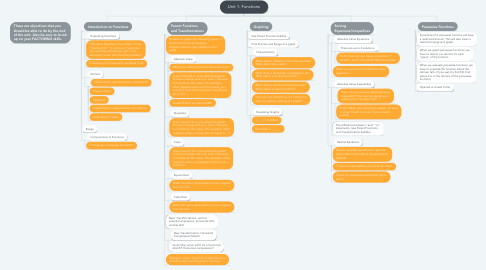
1. Introduction to Functions
1.1. Evaluating Functions
1.1.1. Difference Quotient [ f(x+h)-f(x) ] / h (an "introduction" to calculus.) You know you're doing something right if the exponent is one less than the problem!
1.1.2. Evaluating Functions with variables (f(-k))
1.2. Domain
1.2.1. When/where can domain be undefined?
1.2.1.1. Square Root?
1.2.1.2. Rational?
1.2.1.3. Square Root in Denominator (of rational)
1.2.1.4. Cube Root? Cubic?
1.3. Range
1.4. Compositions of Functions
1.4.1. How do you compose functions?
2. Graphing
2.1. See Parent Function bubble
2.2. Find Domain and Range of a graph
2.3. Characteristics
2.3.1. What does a reflection over the x-axis do? What about the y-axis?
2.3.2. What does a horizontal compression do? What about a horizontal stretch?
2.3.3. What does a vertical compression do? What about a vertical stretch?
2.3.4. How you can determine if a function is even or odd by looking at a graph?
2.4. Evaulating Graphs
2.4.1. f(____) = number
2.4.2. f(number) = ______
3. Parent Functions and Transformations
3.1. Be able to graph the following types of toolkit functions and explain transformations. (see bubble on the right)
3.2. Absolute Value
3.2.1. What's the definition of an absolute value?
3.2.2. Given a*(|x+b|)+c, how does the parent function change with a, b, and c? Be sure to include all the cases. For example, what happens when a=0 (of course, you wouldn't want that, because it would just be y=c!)?
3.2.3. GreatOR than vs. Less thAND
3.3. Quadratic
3.3.1. Given a(x+b)^2+c, how does the parent function change with a, b, and c? Be sure to include all the cases. For example, what happens when a is less than or equal to -1?
3.4. Cubic
3.4.1. Given a(x+b)^3+c, how does the parent function change with a, b, and c? Be sure to include all the cases. For example, what happens when a is between 0 and 1 (i.e. a fraction)?
3.5. Square Root
3.5.1. Make the same generalizations for a square root function.
3.6. Cube Root
3.6.1. Make the same generalizations for a square root function.
3.7. Basic Transformations: vertical stretch/compression, horizontal shift, vertical shift.
3.8. New Transformation: Horizontal Compression/Stretch
3.8.1. Given f(bx), when will b be a horizontal stretch? Horizontal compression?
3.9. Example: Given .5(x-2)^2+8, describe this transformation and its parent function.
4. Solving Equations/Inequalities
4.1. Absolute Value Equations
4.1.1. There are up to 2 solutions.
4.1.1.1. Think: how can you have no solution, 1 solution, and 2 solutions? Make examples!
4.1.2. How can you solve an absolute value equation?
4.2. Absolute Value Inequalities
4.2.1. How can you solve an absolute value inequality? How can you graph your solution on a number line?
4.2.1.1. Think: When you have your answer, be sure to plug it back in to see if your results match!
4.2.2. The difference between "and" "or" statements. (see Parent Functions and Transformation bubble)
4.3. Radical Equations
4.3.1. Review simplifying radicals in general (even side of the radical review sheet is helpful)
4.3.2. To remove the radical, you must do what?
4.3.3. Check for extraneous solutions! (how? why?)

